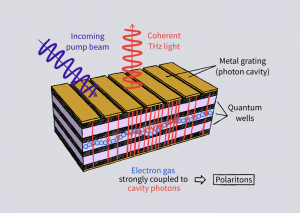Summary
An efficient source of terahertz radiation has the potential to improve characterization methods for drugs, proteins and bacteria, enable ultra-fast wireless data transfer over short distances for use in “smart factories”, and offer enhanced detection capabilities with the ability to see through packaging. However, terahertz light is particularly difficult to produce, and existing sources remain too bulky and power-hungry for widespread application.
We are working to develop more compact and efficient terahertz light sources using polaritons – hybrid particles consisting of a photon coupled strongly with a material excitation. This approach utilizes a plethora of quantum phenomena, from trapped photons, to quasiparticles, to Bose-Einstein condensation. By exploiting these unconventional effects we hope to pave the way towards a long-awaited practical source of terahertz light.

Related Content
Implementing High-fidelity Quantum Gates in Multi-level Trapped Ions
Summary The scalability of quantum processors is limited by current error rates for single-qubit gates. By encoding more than a single bit of information within a single ion, multi-level “qudits” offer a promising method of increasing the information density within a quantum processor, and therefore minimizing the number of gates and associated error rates. […]
July 30, 2018

Quantum Simulations of Fundamental Interactions
Summary To address questions in modern physics such as “what is the structure of matter inside neutron stars?” we need better computational methods to evaluate the interplay of fundamental forces between elementary particles. To-date the response to such questions rests on numerical computer simulations that are inherently limited. In this project, we develop new theoretical […]
April 18, 2019

Chiral Quantum Antenna Based on Multilayer Metasurface
Summary Individual atoms can act as stationary qubits and thus serve as nodes in quantum computing networks or as memories for quantum repeaters. However, to successfully use qubits based on single atoms suspended in free space, photons emitted by a single atom need to be efficiently collected. Conventionally, this can be done with high […]
September 20, 2018
Advanced microwave electronics enabling quantum technologies
Summary Superconducting quantum computers require quantum-limited measurements at microwave frequencies in order to implement error correction. Conventionally, this is accomplished using near quantum-limited Josephson Parametric Amplifiers (JPAs). The JPAs require bulky ferrite-based circulators that prevent on-chip integration of the amplifiers with the processor and take up the majority of space and cooling power in the […]
April 1, 2020

